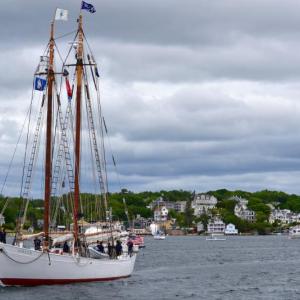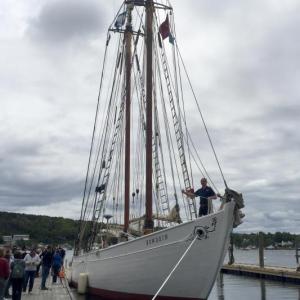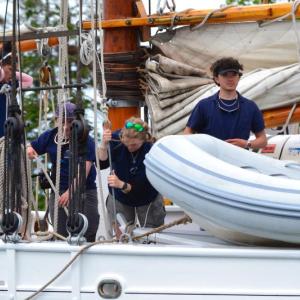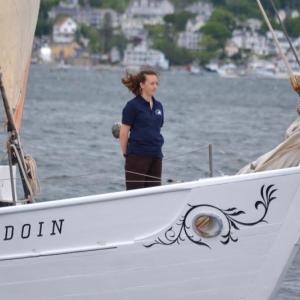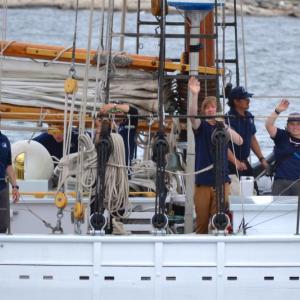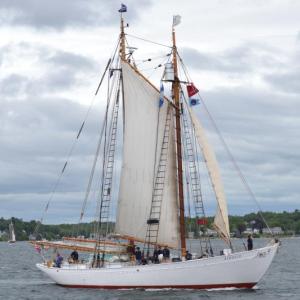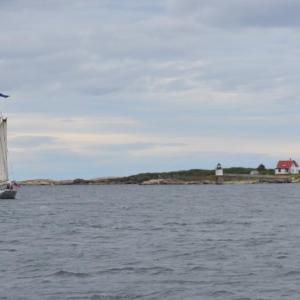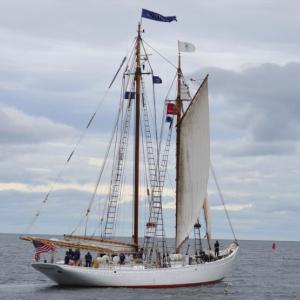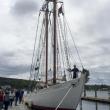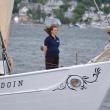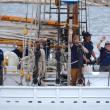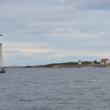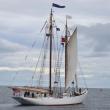With eyes on past and future, schooner Bowdoin sets sail
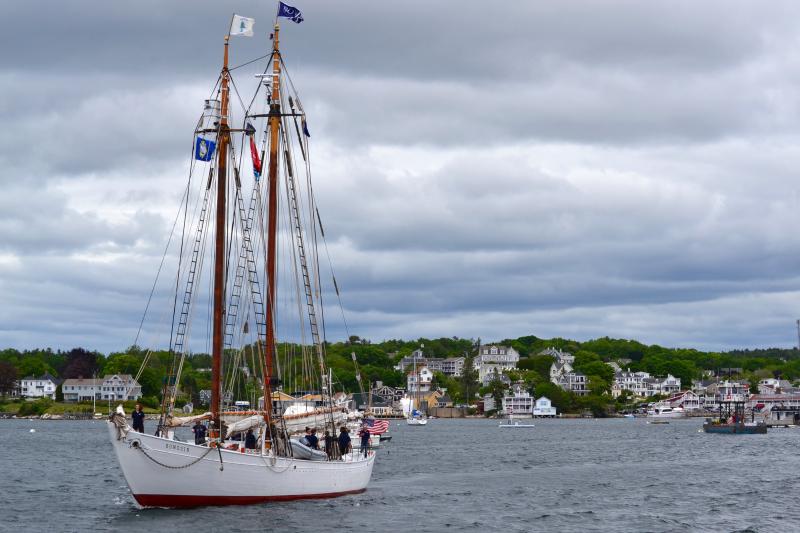 The schooner Bowdoin leaves Boothbay Harbor. FRITZ FREUDENBERGER/Boothbay Register
The schooner Bowdoin leaves Boothbay Harbor. FRITZ FREUDENBERGER/Boothbay Register Bowdoin docked in town before its departure. FRITZ FREUDENBERGER/Boothbay Register
Bowdoin docked in town before its departure. FRITZ FREUDENBERGER/Boothbay Register Crew members prepare for their voyage. Landen Parks, second from right, is the great-great-granddaughter of a former Bowdoin crew member who sailed in 1929. FRITZ FREUDENBERGER/Boothbay Register
Crew members prepare for their voyage. Landen Parks, second from right, is the great-great-granddaughter of a former Bowdoin crew member who sailed in 1929. FRITZ FREUDENBERGER/Boothbay Register FRITZ FREUDENBERGER/Boothbay Register
FRITZ FREUDENBERGER/Boothbay Register FRITZ FREUDENBERGER/Boothbay Register
FRITZ FREUDENBERGER/Boothbay Register Bowdoin with the Eastwind in the background. FRITZ FREUDENBERGER/Boothbay Register
Bowdoin with the Eastwind in the background. FRITZ FREUDENBERGER/Boothbay Register Bowdoin sails past Ram Island. FRITZ FREUDENBERGER/Boothbay Register
Bowdoin sails past Ram Island. FRITZ FREUDENBERGER/Boothbay Register FRITZ FREUDENBERGER/Boothbay Register
FRITZ FREUDENBERGER/Boothbay Register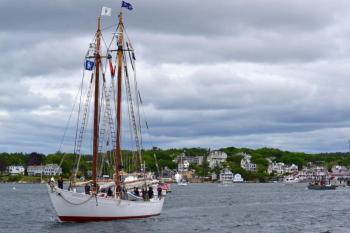 The schooner Bowdoin leaves Boothbay Harbor. FRITZ FREUDENBERGER/Boothbay Register
The schooner Bowdoin leaves Boothbay Harbor. FRITZ FREUDENBERGER/Boothbay Register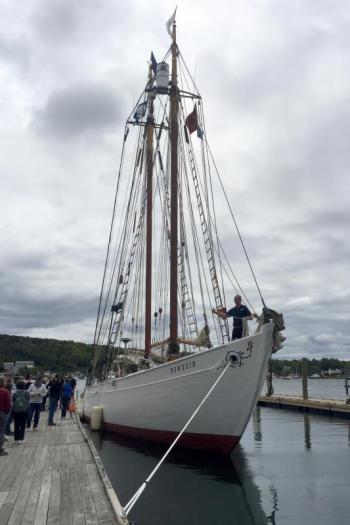 Bowdoin docked in town before its departure. FRITZ FREUDENBERGER/Boothbay Register
Bowdoin docked in town before its departure. FRITZ FREUDENBERGER/Boothbay Register Crew members prepare for their voyage. Landen Parks, second from right, is the great-great-granddaughter of a former Bowdoin crew member who sailed in 1929. FRITZ FREUDENBERGER/Boothbay Register
Crew members prepare for their voyage. Landen Parks, second from right, is the great-great-granddaughter of a former Bowdoin crew member who sailed in 1929. FRITZ FREUDENBERGER/Boothbay Register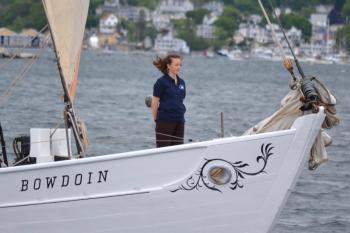 FRITZ FREUDENBERGER/Boothbay Register
FRITZ FREUDENBERGER/Boothbay Register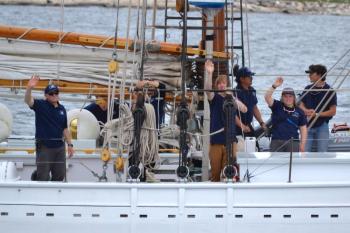 FRITZ FREUDENBERGER/Boothbay Register
FRITZ FREUDENBERGER/Boothbay Register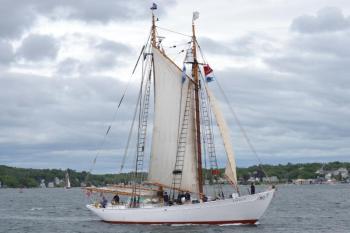 Bowdoin with the Eastwind in the background. FRITZ FREUDENBERGER/Boothbay Register
Bowdoin with the Eastwind in the background. FRITZ FREUDENBERGER/Boothbay Register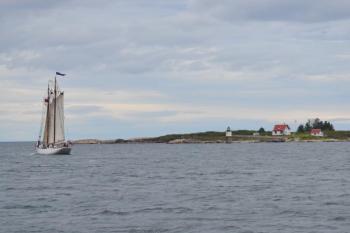 Bowdoin sails past Ram Island. FRITZ FREUDENBERGER/Boothbay Register
Bowdoin sails past Ram Island. FRITZ FREUDENBERGER/Boothbay Register FRITZ FREUDENBERGER/Boothbay Register
FRITZ FREUDENBERGER/Boothbay RegisterHistory came alive in Boothbay Harbor June 6. A small crowd gathered at the docks on a crisp, cloudy afternoon to wish the classic schooner Bowdoin and its crew a safe voyage. The ship set sail for a six-week trip to Newfoundland and Labrador, channeling historic expeditions it has taken for over a century.
The Bowdoin, the official sailing vessel of Maine, was built in 1921 by Hodgdon Brothers Shipyard in East Boothbay for explorer and researcher Donald MacMillan to work in the Arctic. According to Maine Maritime Academy, which has owned the vessel since 1988, Bowdoin has made 28 voyages north of the Arctic Circle. Historically, these trips often departed from Wiscasset or Boothbay Harbor.
This particular trip is a college course for eight students, six from MMA and two from Bowdoin College, to learn seamanship under sail. One student is descended from a former Bowdoin crew member.
"This is a voyage of a lifetime. It’s a voyage of self-discovery. It’s sail training in its purist form,” said Captain Alexander Peacock at a celebration the night before departure. “It’s carrying out history and the legacy, but also looking forward and keeping it alive. Bowdoin is still doing what she was built for 102 years ago, so it's pretty exciting."
Peacock said the route takes Bowdoin 3,000 total nautical miles. The crew will travel past Nova Scotia, up the Newfoundland and Labrador coast, eventually going to Naine. Peacock said this is a route MacMillan took many times, and he had friends along the way. However, this voyage veers eastward to give the students more sea time away from the coast.
According to Peacock, there are no course prerequisites to join the cruise; each student is considered crew, with responsibilities to themselves, their mates and the ship.
Peacock said the experience gets to the grassroots of seamanship. The students have to learn to work in a tight-knit group though adversity, challenges and changes. He said whether they go into a maritime career or not, the goal is to learn about leadership and cooperation.
“What that all comes down to is the attitude you approach things with, not all the skills you know. How you approach certain circumstances and how you work together as a crew,” he said.
The night before departure, Peacock spoke to a small gathering celebrating the Bowdoin and maritime history in the region. He said the event took place on the wharf the Bowdoin would historically depart from, present-day Mine Oyster.
Several others spoke at the dinner, put together by Mark Gimbel of Boothbay Harbor, who invited the Bowdoin and crew to town. "Local historian Jon Dunsford talked about the Bowdoin’s unique design, which makes it particularly capable for the Arctic. Overall, Bowdoin is 88 feet long, 21 feet wide and weighs 60 tons. It has features such as a reinforced hull shaped to lift the ship out of the ice, an oversized rudder to quickly steer in narrow channels, and stout masts to handle Arctic winds, which, according to Peacock, are either too much or too little.
Dunsford also gave a brief overview of the history of the Bowdoin, MacMillan and their trips to the Arctic. He discussed a few expeditions to Newfoundland, Labrador and Greenland that used the vessel to conduct scientific studies, aid military efforts, set up schools and make cultural connections.
Peacock said he the ship has not been to Labrador in 15 years, and this will be his first time. He hopes to rekindle some of the connections Bowdoin has made. He brought photographs from historical archives and hopes to meet people, or their descendants, who have connections to the ship.
One of those connections lives in the region. David Nutt of Edgecomb spoke about his father’s time with the Bowdoin. His father, David C. Nutt, a scientist and mariner, was the executive officer on the Bowdoin for two years. Then he brought his own ship, Blue Dolphin, to Maine for his own Arctic research.
Another connection is on the voyage. Landen Parks is the great-great-granddaughter of William Converse Kendall, who sailed aboard the Bowdoin in 1929 with MacMillan. According to Parks, the crew made the journey to help set up a school in Nain, but Kendell went along to study Arctic fish species.
Parks, who just finished her freshman year at MMA, studies small vessel operations and marine biology and hopes to combine traditional sailing with science for her career. During the trip, she plans to take samples and help with research to study microplastics and how they interact with the ocean.
At first Parks did not realize she was following in her relative’s footsteps. However, she said when she came to MMA, her aunt showed her photos and journals from Kendall; it struck her how significant the experience was for the family.
“Now I'm on that track too, so I'm really excited,” she said. "It’s really exciting to follow in his footsteps and make this a full circle moment."

